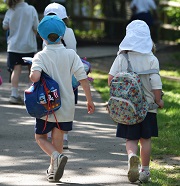08 July 2019
 A national survey by University of South Australia researchers has exposed serious gaps in the ability of early childhood teachers, primary educators and carers to identify and respond to young children displaying “problematic sexual behaviours”.
A national survey by University of South Australia researchers has exposed serious gaps in the ability of early childhood teachers, primary educators and carers to identify and respond to young children displaying “problematic sexual behaviours”.
Associate Professor Elspeth McInnes and Dr Lesley-Anne Ey say increasing reports of children under 10 years of age exhibiting harmful sexual behaviour towards each other are concerning.
The apparent increase can be attributed to a range of factors, including sexual abuse and exposure to pornography, trauma, domestic violence, and drug or alcohol abuse in the home. Research indicates that all these events can lead to problematic sexual behaviours (PSB) among children.
The researchers, from UniSA’s School of Education, say although educators are required to report suspected child abuse to child protection services, harmful sexual behaviour between children is more challenging.
The term ‘problematic sexual behaviours’ (PSB) is used to describe abnormal and harmful sexual behaviour displayed by young children that falls outside the bounds of curiosity and natural exploration. It can involve coercion, threats, secrecy, violence and/or aggression.
In an article published in Sex Education: Sexuality, Society and Learning, lead author Assoc Prof McInnes and her colleague Dr Ey discuss the findings of an online survey involving 107 educators from state, independent and Catholic primary schools, pre-schools and care organisations.
“Australian teachers have reported witnessing primary school children displaying problematic sexual behaviours,” says Assoc Prof McInnes. “This points to an increasing need for better training for educators and carers.”
A 2016 report found that child-on-child sexual assaults nearly doubled in NSW, from 44 in 2006 to 80 in 2015, while the number of indecent assaults between children more than doubled from 33 to 73 in the same period.
In Victoria, referrals relating to children with PSB increased from 10-15 per year a decade ago to more than 200 a year in 2016.
The Royal Commission into Institutional Responses to Child Sexual Abuse also reported that 23.4 per cent of the 7981 survivors interviewed said they were sexually abused by another child.
The problem is exacerbated because young children are not easily able to access therapeutic help, the researchers say. Under the Young Offenders Act, children aged under 10 are not considered capable of forming criminal intent.
“This leaves the responsibility to teachers and carers to identify whether children have crossed the line from curiosity to problematic sexual behaviour,” Assoc Prof McInnes says. “And if they fail to report suspected PSBs to child protection services they can be held culpable.”
Teachers are calling for more training to improve their understanding of PSB so they can respond appropriately to children and families.
The study found that both boys and girls demonstrated problematic sexual behaviours towards their own gender as well as the opposite sex.
Additional information
“Responding to problematic sexual behaviours of primary school children: supporting care and education staff” is published in Sex Education: Sexuality, Society and Learning. For a copy of the paper, please email Candy.Gibson@unisa.edu.au or Elspeth.McInnes@unisa.edu.au
Media contact: Candy Gibson office +61 8 8302 0961 mobile: +61 434 605 142
email: candy.gibson@unisa.edu.au
Lead researcher Assoc Prof Elspeth McInnes office: +61 8 8302 4042
mobile: +61 421 787 080 email: Elspeth.mcinnes@unisa.edu.au



